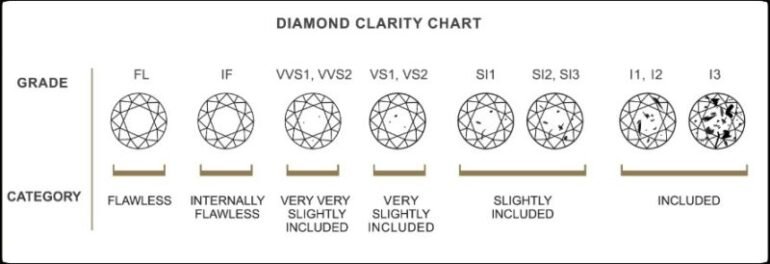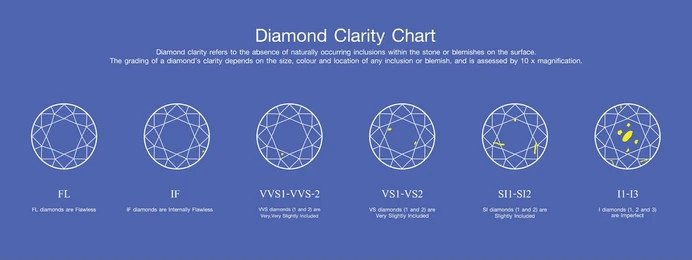100% Lab Grown Diamonds | Ethically Sourced | Budget-Friendly | Beautifully Crafted

Diamond Clarity
- Home
- Page
During the diamond growth process, microscopic impurities or imperfections become present within the diamond. These imperfections are known as diamond inclusions. Inclusions are extremely common within diamonds and are essentially birthmarks that give every diamond uniqueness. You may have heard the phrase “no two diamonds are ever alike.” Well, inclusions are the reason. No two diamonds will have the same number, size, location, and type of inclusions, even if they have the same clarity grade assigned by GIA or IGI.
Inclusions have direct implications on a diamond’s sparkle. Inclusions, again, depending on the size, number, location, and type can reduce diamond sparkle by preventing light from refracting and passing through the diamond and back to your eye. Based on the factors mentioned above, a diamond’s clarity is subjectively graded and set in a range. This range is known as the diamond clarity scale. It was created by GIA and is the industry-wide standard for diamond grading and comparison. This diamond clarity rating is the one that is most respected for accuracy and consistency.
Diamonds are considered the world’s most precious gemstones.
- When evaluating the 4C’s, clarity is the third most important characteristic because most imperfections cannot be seen unless under at least 10 times magnification. (Cut is the most important 4C to consider)
- Clarity refers to tiny imperfections that occur naturally called inclusions. Diamonds with the least and smallest inclusions obtain the highest clarity grades by GIA.
- To maximize your budget, consider an SI-quality diamond, knowing that it may have very slight inclusions visible to the naked eye if the stone is examined very closely. Generally, it’s not the case.
Clarity refers to the tiny, natural imperfections that are present in all but the rarest and highest quality diamonds. The less inclusions, the better the clarity. The better the clarity, the more sparkle and light performance. Gemologists refer to these imperfections by a variety of technical names, including blemishes and inclusions. Because these imperfections tend to be microscopic, they do not generally affect a diamond’s beauty in any discernible way.
Clarity Scale
Diamonds range in clarity from FL – I3. Inclusions are examined at 10x magnification. Inclusions up to a certain range can only been seen under magnification oftentimes only by a diamond expert, but those in lower clarities that are not considered eye-clean have inclusions that can be seen by the naked eye as well.

The precise location of a blemish or inclusion critically determines whether it can be witnessed in the final finished diamond. An expert diamond cutter ardently strives to craft a stone where such imperfections remain largely invisible to the naked eye. Hence, inclusion is much more likely to hide close to the girdle or beneath the bezel facets as they are quite harder to be seen from these angles.
Evaluating a diamond’s clarity entails ascertaining multiple aspects such as the size of these characteristics, their position, number, and contour. The process also involves determining how these imperfections ultimately affect a diamond’s overall appearance. No diamond is free from these peculiarities and perfectly clean. However, any diamond that comes closer to this intense purity, earns a higher value. The clarity also determines the value when you want to sell diamonds in Houston.
Buy a diamond based on its clarity?
The GIA has created an extensive 11-point clarity scale to grade diamond clarity. This scale grades the clarity of a diamond by considering and judging each flaw only under extreme 10x magnification.

FL
IF
VVS1
VVS2
VS1
VS2
SI1
SI2
I1
FL
Flawless: a FL diamond has no inclusions or characteristics (blemishes) inside or on its surface. It is extremely rare and is an exquisite symbol of perfection. Less than 0.1% of all gem quality diamonds are in this category. They have the highest premium and are typically found in smaller sized diamonds. With this clarity you cannot see any inclusions or blemishes even with 10x magnification and those too can only be found by a skilled grader.
IF
Flawless: a FL diamond has no inclusions or characteristics (blemishes) inside or on its surface. It is extremely rare and is an exquisite symbol of perfection. Less than 0.1% of all gem quality diamonds are in this category. They have the highest premium and are typically found in smaller sized diamonds. With this clarity you cannot see any inclusions or blemishes even with 10x magnification and those too can only be found by a skilled grader.
VVS1
Very, Very Slightly Included 1: a VVS1 diamond has very minute inclusions that are extremely small, and often undetectable by many diamond professionals, even under 10x magnification. VVS1 offers a much better value than FL or IF and still has virtually the same appeal. Diamond sparkle is unaffected as the inclusions are so small that light is barely affected. The most common VVS1 inclusions are pinpoint and natural. Typically, VVS1 inclusions are only visible from the pavilion, under magnification. To the naked eye, the inclusions are not visible making these diamonds eye-clean. Learn more about VVS diamonds.
VVS2
Very, Very Slightly Included 2: a VVS2 diamond has very minute inclusions that are extremely small, but are slightly more visible under magnification than VVS1. This clarity grade is considered the best value of the higher clarities and does not compromise your diamond’s brilliance. Inclusions can rarely be found, even under 10x magnification. The most common VVS2 inclusions include cloud, pinpoint, feather and natural. Learn more about VVS diamonds.
VS1
Very, Very Slightly Included 2: a VVS2 diamond has very minute inclusions that are extremely small, but are slightly more visible under magnification than VVS1. This clarity grade is considered the best value of the higher clarities and does not compromise your diamond’s brilliance. Inclusions can rarely be found, even under 10x magnification. The most common VVS2 inclusions include cloud, pinpoint, feather and natural. Learn more about VVS diamonds.
VS2
Very Slightly Included 2: a VS2 diamond has very minor inclusions that look only slightly larger than a VS1 under magnification. A VS2 is not noticeable to the unaided eye and is extremely popular because its value allows you to focus your budget on another Cut, Color or Carat. VS2 diamonds tend to have a few more inclusions than VS1 and the size is slightly larger, while still microscopic. The common VS2 inclusions include crystal, feather, indented natural, cloud and twinning wisp. The location of inclusions isn’t very impactful in VS diamonds. Learn more about VS diamonds.
SI1
Slightly Included 1: Additionally, we recommend choosing SI diamonds with more inclusions rather than a single inclusion. With a single grade setting inclusion, it must be larger and more visible in order to be an SI clarity diamond. The common SI1 diamond inclusions are crystal Slightly Included 1: a SI1 diamond will sparkle brilliantly even with its minor inclusions that may be invisible to the unaided eye. SI1 is extremely popular because its value allows you to focus your budget on another Cut, Color or Carat. It is considered a high clarity grade at a great price. In SI diamonds, it is recommended to choose diamonds with inclusions that are off center and closer to the girdle of the diamond. These are rarer to find and so they carry a Premium feather, twinning wisp, cloud, knot and indented natural. SI diamonds.
Be wary of single crystals or clouds that they can be eye visible or make the diamond look hazy, cloudy or milky. Be sure to analyze diamonds on a case by case basis so that you are getting one of excellent quality.
SI2
Slightly Included 2: an SI2 diamond will possess high sparkle and is comprised by clarity inclusions that may be visible without magnification, when examined closely. Most SI2 inclusions are undetectable to the unaided eye. SI clarity grades tend to offer great value. Like SI1 diamonds, avoid larger, single inclusions. On the GIA report, these can be identified by the diamond plot where inclusions are marked or by the inclusion comments.
Avoid SI2 diamonds that have a grade setting inclusion that is cloud or a large, center crystal. Crystals in SI diamonds are typically black and so they are more visible without magnification. Common SI2 inclusions are larger crystals, twinning wisps, feathers, clouds and knots. SI diamonds.
I1
Slightly Included 2: an SI2 diamond will possess high sparkle and is comprised by clarity inclusions that may be visible without magnification, when examined closely. Most SI2 inclusions are undetectable to the unaided eye. SI clarity grades tend to offer great value. Like SI1 diamonds, avoid larger, single inclusions. On the GIA report, these can be identified by the diamond plot where inclusions are marked or by the inclusion comments.
Avoid SI2 diamonds that have a grade setting inclusion that is cloud or a large, center crystal. Crystals in SI diamonds are typically black and so they are more visible without magnification. Common SI2 inclusions are larger crystals, twinning wisps, feathers, clouds and knots. SI diamonds.

